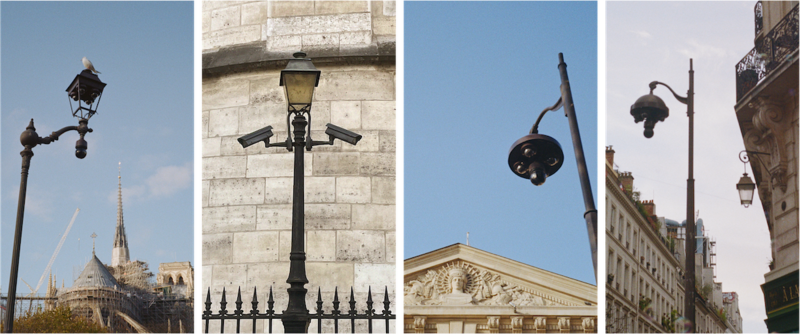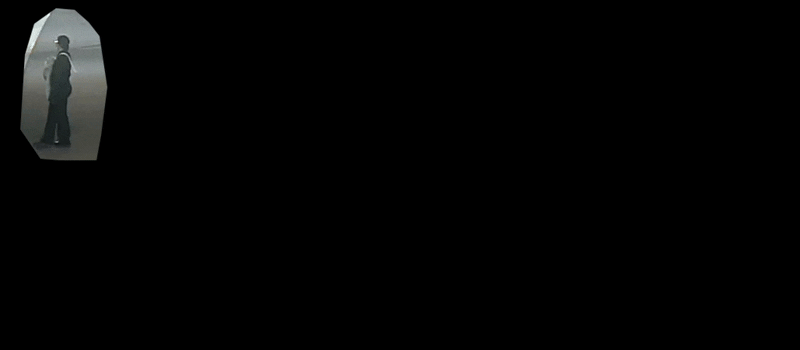Maja Funke - Dead Glitch: Difference between revisions
From CTPwiki
No edit summary |
No edit summary |
||
| Line 13: | Line 13: | ||
While walking Paris in dérive<ref>https://situationist.org/periodical/si/issue-2-1958-en/theory-of-the-derive-73</ref>, one might sense the onset of normalization of the New Military Urbanism<ref name=":1">Graham, Stephen: ''Cities Under Siege: The New Military Urbanism''. Verso, 2010.</ref>. Counter observation reveals the banalization of a watching city. In the multimedia body of work »Dead Glitch« this walk becomes an investigative performance. In playing with the current legal situation in Paris, the proclaimed zones of AVS are becoming a stage, with the security apparatus documenting the everyday risk-management of the performer and becoming acutely conscious of the resulting instruments of recognition<ref>Boehm, Gottfried'': Zwischen Auge und Hand : Bilder als Instrumente der Erkenntnis.'' In: ''Mit dem Auge denken : Strategien der Sichtbarmachung in wissenschaftlichen und virtuellen Welten.'' Zürich, 2001, pp. 43-54. </ref> (Fig. 2)''.'' The performers journey of becoming data and losing its anonymity and privacy is highlighting these same values a vital for freedom like demonstration, movement and expression. [[File:Jxmaja deadglitch vsavideo.gif|thumb|800x800px|Fig. 2: Surveillance video by SNCF, masking in original, cropped and sped up. (gif) |center]]And yet, as states adopt surveillance and control systems designed for warfare<ref name=":1" /> – driven by security concerns, economic interests, and political goals – privacy violations become the norm. These measures, initially temporary, often become permanent after the state of emergency, treating all citizens as suspects and placing AVS in fundamental conflict with democratic values. The title »Dead Glitch« alludes not least to the deadly potential for error entailed by trust in these technologies. »Warfare, like everything else, is being urbanized«<ref name=":1" /> and the boomerang of dataveillance is returning to state borders and war zones.<ref>Foucault, Michel: ''Society Must be Defended: Lectures at the Collège de France 1975-76,'' Penguin Classics 2020.</ref> Extreme versions of this logic are visible in the automated systems employed in border control (the European security regime)<ref>"Wie die EU mit Künstlicher Intelligenz ihre Grenzen schützen will", ''Algorithm Watch, ZDF Magazine Royale'' 24 May, 2025. https://fuckoffai.eu/<nowiki/>Accessed November 11, 2024. </ref> , AI supported military systems (such as in Gaza)<ref>"Targeted? Killing", ''Forum InformatikerInnen für Frieden'', 29 April, 2024. https://blog.fiff.de/content/files/2024/04/2024_04_29_Stellungnahme-lavender.pdf. Accessed 3 May, 2024 and "‘Lavender’: The AI machine directing Israel’s bombing spree in Gaza", ''+972 Magazine'', 3 April, 2024. https://www.972mag.com/lavender-ai-israeli-army-gaza/ Accessed April 15, 2024.</ref>, as well as in various other developments including Russian and Chinese where the digitalization of warfare is transforming the role of citizens under the Geneva Conventions.<ref>Mulligan, Cathy: ''Automated Warfare and the Geneva Convention''. Netzpolitik, 17 April, 2024. https://netzpolitik.org/2024/artificial-intelligence-automated-warfare-and-the-geneva-convention/?via=nl Accessed 11 November, 2024. </ref> | While walking Paris in dérive<ref>https://situationist.org/periodical/si/issue-2-1958-en/theory-of-the-derive-73</ref>, one might sense the onset of normalization of the New Military Urbanism<ref name=":1">Graham, Stephen: ''Cities Under Siege: The New Military Urbanism''. Verso, 2010.</ref>. Counter observation reveals the banalization of a watching city. In the multimedia body of work »Dead Glitch« this walk becomes an investigative performance. In playing with the current legal situation in Paris, the proclaimed zones of AVS are becoming a stage, with the security apparatus documenting the everyday risk-management of the performer and becoming acutely conscious of the resulting instruments of recognition<ref>Boehm, Gottfried'': Zwischen Auge und Hand : Bilder als Instrumente der Erkenntnis.'' In: ''Mit dem Auge denken : Strategien der Sichtbarmachung in wissenschaftlichen und virtuellen Welten.'' Zürich, 2001, pp. 43-54. </ref> (Fig. 2)''.'' The performers journey of becoming data and losing its anonymity and privacy is highlighting these same values a vital for freedom like demonstration, movement and expression. [[File:Jxmaja deadglitch vsavideo.gif|thumb|800x800px|Fig. 2: Surveillance video by SNCF, masking in original, cropped and sped up. (gif) |center]]And yet, as states adopt surveillance and control systems designed for warfare<ref name=":1" /> – driven by security concerns, economic interests, and political goals – privacy violations become the norm. These measures, initially temporary, often become permanent after the state of emergency, treating all citizens as suspects and placing AVS in fundamental conflict with democratic values. The title »Dead Glitch« alludes not least to the deadly potential for error entailed by trust in these technologies. »Warfare, like everything else, is being urbanized«<ref name=":1" /> and the boomerang of dataveillance is returning to state borders and war zones.<ref>Foucault, Michel: ''Society Must be Defended: Lectures at the Collège de France 1975-76,'' Penguin Classics 2020.</ref> Extreme versions of this logic are visible in the automated systems employed in border control (the European security regime)<ref>"Wie die EU mit Künstlicher Intelligenz ihre Grenzen schützen will", ''Algorithm Watch, ZDF Magazine Royale'' 24 May, 2025. https://fuckoffai.eu/<nowiki/>Accessed November 11, 2024. </ref> , AI supported military systems (such as in Gaza)<ref>"Targeted? Killing", ''Forum InformatikerInnen für Frieden'', 29 April, 2024. https://blog.fiff.de/content/files/2024/04/2024_04_29_Stellungnahme-lavender.pdf. Accessed 3 May, 2024 and "‘Lavender’: The AI machine directing Israel’s bombing spree in Gaza", ''+972 Magazine'', 3 April, 2024. https://www.972mag.com/lavender-ai-israeli-army-gaza/ Accessed April 15, 2024.</ref>, as well as in various other developments including Russian and Chinese where the digitalization of warfare is transforming the role of citizens under the Geneva Conventions.<ref>Mulligan, Cathy: ''Automated Warfare and the Geneva Convention''. Netzpolitik, 17 April, 2024. https://netzpolitik.org/2024/artificial-intelligence-automated-warfare-and-the-geneva-convention/?via=nl Accessed 11 November, 2024. </ref> | ||
When video surveillance is not a material apparatus, but a practice<ref name=":0" />, there is place to argue for a proximity to social justice<ref>"Intelligence artificielle : la France ouvre la voie à la surveillance de masse en Europe", ''Disclose'', 22 January, 2025 https://disclose.ngo/fr/article/intelligence-artificielle-la-france-ouvre-la-voie-a-la-surveillance-de-masse-en-europe. Accessed 22 January, 2025. </ref> and bringing back in mind that historically, antifascist countermovements strenghen in response to a tightening of state security.<blockquote>»By adding cameras, the idea of the romantic city, the city of the flâneur, has shifted. Contemporary city management seems to have different expectations of what public space is and does. Your artistic strategy to claim CCTV data by using GDPR regulations is a wonderful strategy of resistance. This is a laborious endeavour, both for you and the city, that slows down the cogs of the surveillance machine. It functions as a strong example of what "surveillance as a practice" entails, and how CCTV is so much more than mere technology, but a site of contestation.« – as commented by Ruben van de Ven </blockquote><blockquote>»2024 Parisian city surveillance is very effective for me, particularly how you aim to understand what "dataveillance" does in crafting, and controlling, citizens' behavior. Thinking alongside Shannon Mattern (particularly her book The City Is Not a Computer), I'd argue that autonomous systems of surveillance might have changed their distribution of materials, but these systems have been equally present in urban design before the CCTV era.« – as commented by Kola Heyward-Rotimi </blockquote> | When video surveillance is not a material apparatus, but a practice<ref name=":0" />, there is place to argue for a proximity to social justice<ref>"Intelligence artificielle : la France ouvre la voie à la surveillance de masse en Europe", ''Disclose'', 22 January, 2025 https://disclose.ngo/fr/article/intelligence-artificielle-la-france-ouvre-la-voie-a-la-surveillance-de-masse-en-europe. Accessed 22 January, 2025. </ref> and bringing back in mind that historically, antifascist countermovements strenghen in response to a tightening of state security. | ||
<blockquote>»By adding cameras, the idea of the romantic city, the city of the flâneur, has shifted. Contemporary city management seems to have different expectations of what public space is and does. Your artistic strategy to claim CCTV data by using GDPR regulations is a wonderful strategy of resistance. This is a laborious endeavour, both for you and the city, that slows down the cogs of the surveillance machine. It functions as a strong example of what "surveillance as a practice" entails, and how CCTV is so much more than mere technology, but a site of contestation.« – as commented by Ruben van de Ven </blockquote><blockquote>»2024 Parisian city surveillance is very effective for me, particularly how you aim to understand what "dataveillance" does in crafting, and controlling, citizens' behavior. Thinking alongside Shannon Mattern (particularly her book The City Is Not a Computer), I'd argue that autonomous systems of surveillance might have changed their distribution of materials, but these systems have been equally present in urban design before the CCTV era.« – as commented by Kola Heyward-Rotimi </blockquote> | |||
=== References === | === References === | ||

